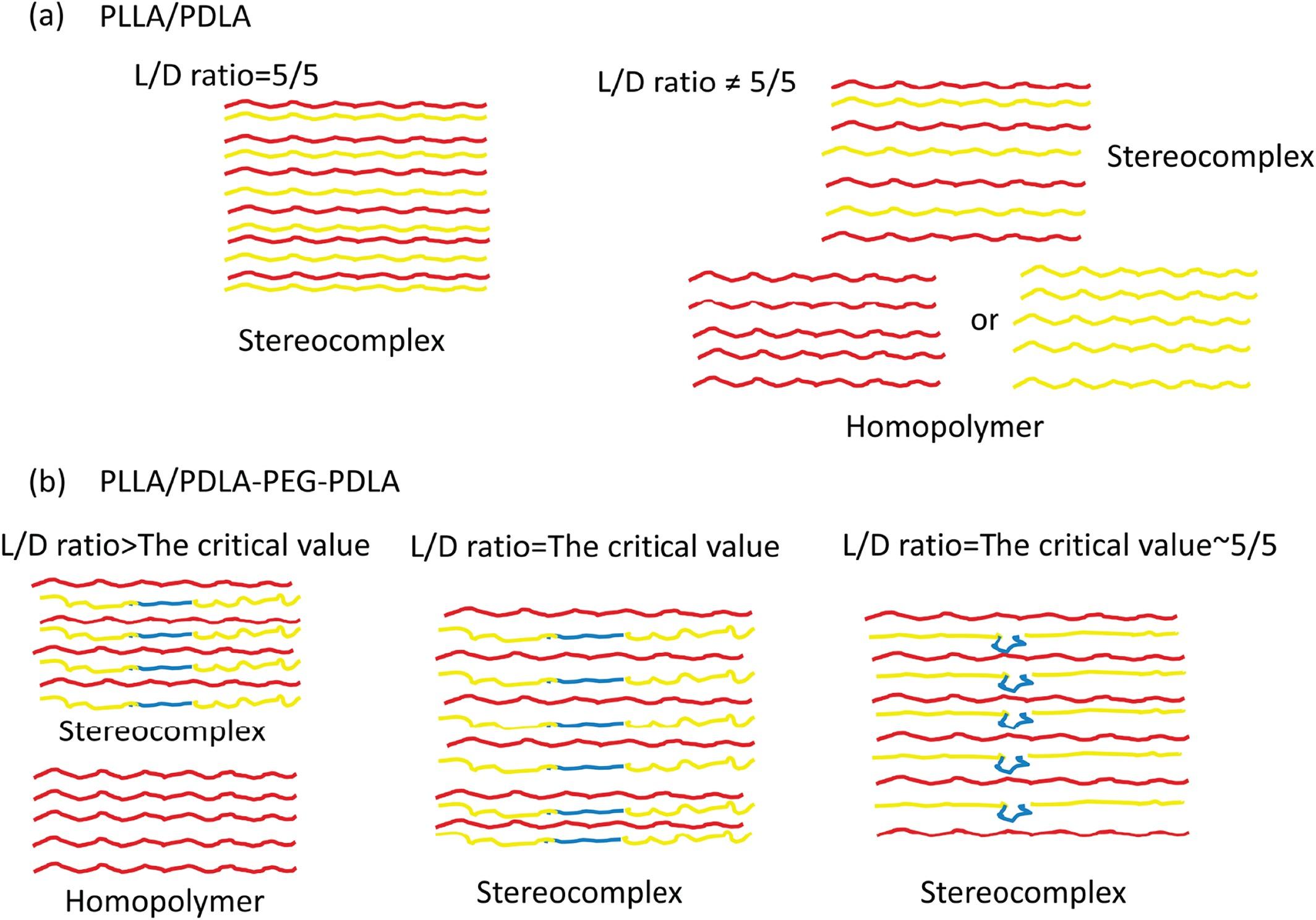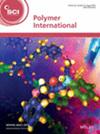下载PDF
{"title":"Investigation of poly(lactide) stereocomplexation between linear poly(L-lactide) and PDLA-PEG-PDLA tri-block copolymer","authors":"Zhanxin Jing, Xuetao Shi, Guangcheng Zhang, Ruiying Lei","doi":"10.1002/pi.4932","DOIUrl":null,"url":null,"abstract":"<p>In this study, stereocomplexed poly(lactide) (PLA) was investigated by blending linear poly(<span>l</span>-lactide) (PLLA) and tri-block copolymer poly(<span>d</span>-lactide) − (polyethylene glycol) − poly(<span>d</span>-lactide) (PDLA-PEG-PDLA). Synthesized PDLA-PEG-PDLA tri-block copolymers with different PEG and PDLA segment lengths were studied and their influences on the degree of sterecomplexation and non-isothermal crystallization behaviour of the PLLA/PDLA-PEG-PDLA blend were examined in detail by DSC, XRD and polarized optical microscopy. A full stereocomplexation between PLLA and PDLA-PEG<sub>4k</sub>-PDLA200 could be formed when the L/D ratio ranged from 7/3 to 5/5 without the presence of PLA homocrystals. The segmental mobility and length of both PEG and PDLA are the dominating factors in the critical D/L ratio to achieve full stereocomplexation and also for nucleation and spherulite growth during the non-isothermal crystallization process. For fixed PEG segmental length, the stereocomplexed PLA formed showed first an increasing and then a decreasing melting temperature with increasing PDLA segments due to their intrinsic stiff mobility. Furthermore, the effect of PEG segmental mobility on PLA stereocomplexation was investigated. The results clearly showed that the crystallization temperature and melting temperature of stereocomplexed-PLA kept increasing with increasing PEG segmental length, which was due to PEG soft mobility in the tri-block copolymers. However, PEG was not favourable for nucleation but could facilitate the spherulite growth rate. Both the PDLA and PEG segmental lengths in the tri-block copolymers affect the crystallinity of stereocomplexed-PLA and the stereocomplexation formation process; they have a different influence on blends prepared by solution casting or the melting method. © 2015 Society of Chemical Industry</p>","PeriodicalId":20404,"journal":{"name":"Polymer International","volume":"64 10","pages":"1399-1407"},"PeriodicalIF":2.9000,"publicationDate":"2015-04-29","publicationTypes":"Journal Article","fieldsOfStudy":null,"isOpenAccess":false,"openAccessPdf":"https://sci-hub-pdf.com/10.1002/pi.4932","citationCount":"21","resultStr":null,"platform":"Semanticscholar","paperid":null,"PeriodicalName":"Polymer International","FirstCategoryId":"92","ListUrlMain":"https://onlinelibrary.wiley.com/doi/10.1002/pi.4932","RegionNum":4,"RegionCategory":"化学","ArticlePicture":[],"TitleCN":null,"AbstractTextCN":null,"PMCID":null,"EPubDate":"","PubModel":"","JCR":"Q2","JCRName":"POLYMER SCIENCE","Score":null,"Total":0}
引用次数: 21
引用
批量引用
Abstract
In this study, stereocomplexed poly(lactide) (PLA) was investigated by blending linear poly(l -lactide) (PLLA) and tri-block copolymer poly(d -lactide) − (polyethylene glycol) − poly(d -lactide) (PDLA-PEG-PDLA). Synthesized PDLA-PEG-PDLA tri-block copolymers with different PEG and PDLA segment lengths were studied and their influences on the degree of sterecomplexation and non-isothermal crystallization behaviour of the PLLA/PDLA-PEG-PDLA blend were examined in detail by DSC, XRD and polarized optical microscopy. A full stereocomplexation between PLLA and PDLA-PEG4k -PDLA200 could be formed when the L/D ratio ranged from 7/3 to 5/5 without the presence of PLA homocrystals. The segmental mobility and length of both PEG and PDLA are the dominating factors in the critical D/L ratio to achieve full stereocomplexation and also for nucleation and spherulite growth during the non-isothermal crystallization process. For fixed PEG segmental length, the stereocomplexed PLA formed showed first an increasing and then a decreasing melting temperature with increasing PDLA segments due to their intrinsic stiff mobility. Furthermore, the effect of PEG segmental mobility on PLA stereocomplexation was investigated. The results clearly showed that the crystallization temperature and melting temperature of stereocomplexed-PLA kept increasing with increasing PEG segmental length, which was due to PEG soft mobility in the tri-block copolymers. However, PEG was not favourable for nucleation but could facilitate the spherulite growth rate. Both the PDLA and PEG segmental lengths in the tri-block copolymers affect the crystallinity of stereocomplexed-PLA and the stereocomplexation formation process; they have a different influence on blends prepared by solution casting or the melting method. © 2015 Society of Chemical Industry
线性聚l -丙交酯与PDLA-PEG-PDLA三嵌段共聚物立体络合的研究
本研究采用线性聚l-丙交酯(PLLA)与三嵌段共聚物聚(d-丙交酯)-聚乙二醇-聚(d-丙交酯)(PDLA-PEG-PDLA)共混的方法研究了立体配合物聚(乳酸)(PLA)。采用DSC、XRD和偏光显微镜研究了不同PEG段长度和PDLA段长度合成的PDLA-PEG-PDLA三嵌段共聚物对PLLA/PDLA-PEG-PDLA共混物立体配合度和非等温结晶行为的影响。当L/D比为7/3 ~ 5/5时,在不存在PLA均晶的情况下,PLLA与PDLA-PEG4k-PDLA200可以形成完全立体络合。PEG和PDLA的节段迁移率和长度是实现完全立体络合的临界D/L比的主要因素,也是非等温结晶过程中成核和球晶生长的主要因素。当PEG段长度固定时,由于固有的刚性迁移率,随着PDLA段的增加,形成的立体配位PLA的熔化温度先升高后降低。此外,还研究了聚乙二醇节段迁移率对聚乳酸立体络合的影响。结果清楚地表明,随着聚乙二醇段长度的增加,立体配位聚乳酸的结晶温度和熔融温度不断升高,这是由于聚乙二醇在三嵌段共聚物中的软迁移。而聚乙二醇不利于球晶的成核,反而有利于球晶的生长。三嵌段共聚物中PDLA和PEG的段长均影响立体络合- pla的结晶度和立体络合形成过程;它们对通过溶液铸造或熔融法制备的共混物有不同的影响。©2015化学工业学会
本文章由计算机程序翻译,如有差异,请以英文原文为准。



